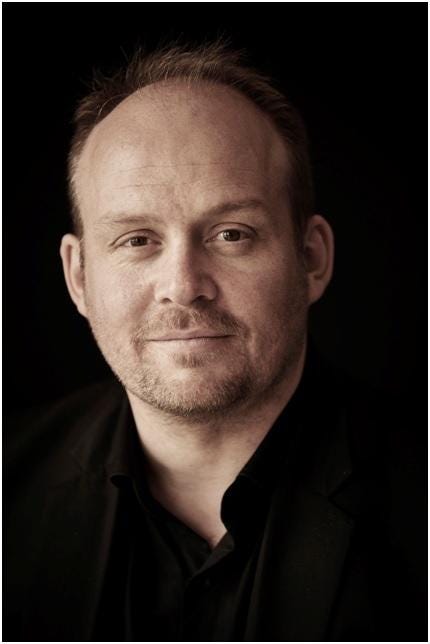Q&A: Simon Thorup, Enterprise Architect Of Sales, Marketing, And Innovation At The Carlsberg GroupQ&A: Simon Thorup, Enterprise Architect Of Sales, Marketing, And Innovation At The Carlsberg Group
A discussion of how one of the largest breweries in the world has handled the journey to digital transformation.

Startups are, by their very nature, digital companies. Regardless of their industry or vertical, they were born into a world where digital services are front and centre in everything we do. They are, from an IT perspective, the digital natives of the business world.
But what if you are not a startup? What if you’re a global corporation, living in a world that is changing more quickly by the day? How do you start that process of digital transformation? information caught up with Simon Thorup, Enterprise Architect of Sales, Marketing, and Innovation at the Carlsberg Group, to see how one of the largest breweries in the world has handled the journey.

information: If you could start by giving us an overview of the Carlsberg Group and some of the challenges it faces from an IT perspective?
Simon Thorup: Carlsberg, the group, is a global company with more than 500 beer brands across the world. We’re present in more than 135 markets, and we have approximately 50,000 employees.
One of the things that makes it quite challenging from an IT perspective at Carlsberg is the fact that we have grown quite fast over the years. We’ve gone from a Danish company to the fourth biggest brewery in the world in a fairly short time. That also means that a lot of different markets are suddenly part of the portfolio, and we need, of course, to find IT solutions to fit their needs.
Another factor is that Carlsberg is primarily present in what we call Western Europe, which is basically Europe without Ukraine and Russia, and then Eastern Europe, which includes Russia, Ukraine, and Kazakhstan, and then Asia. Those three regions are fairly different from each other, both in terms of markets and culture, so we need to have different IT services to each market.
When we talk about logistics and distribution in Denmark, normally it’s a very, very big truck delivering something. But distribution in Vietnam might be a son driving on his scooter on behalf of his mother and father who have a small store where they sell beer. So there are some pragmatic things that are very different from market to market.
IW: You’ve grown through a heavy period of acquisitions, so you’ve probably got quite a disparate ecosystem when it comes to IT. What have you done in terms of consolidating the various platforms that you’re using around the world?
ST: One of the things we’ve done from a regional perspective is to see what makes sense in Asia, what makes sense in Eastern Europe, what makes sense in Western Europe. When it comes to our ERP systems, we have three different approaches. Then on top of that, we’re trying to build some, you could say, global services as well. A lot of these services are within the digital domain, which is not really that dependent on the backend ERP systems. So we can add things like mobility services on top of our regional ERP systems.
IW: “Digital transformation” can be quite a fluffy term, so maybe talk to us a bit about your interpretation of it, and what it means in terms of the enterprise.
ST: Yes, digital transformation is definitely a fluffy term, as is mobility, actually. But digital transformation is, for me, a paradigm shift going from an ERP-centric world to a customer-, consumer-, and value-centric world. From an ERP world, where everything is cost-oriented, where the highest authority is in finance, and everything is measured in terms of cost savings, to a world where we are looking at what value we can actually generate by doing these initiatives.
For me, that’s an organisational change, because most of the big global corporations do have an infrastructure using SAP or Oracle or Microsoft as an ERP backbone. But now we need to generate value on top of the various digital services, whether that’s e-commerce, mobility, Web, or other stuff.
A lot of this also ties into innovation; so, how can we, with the current backbone, with our existing digital services, and with our presence in the markets, how can we generate new services that will provide us with a better experience than our competitors?
IW: Can you give us an idea of where Carlsberg is in this organisational change and that evolution, and maybe an example of some of the new services that you’re talking about?
ST: Currently, we’re building up an e-commerce platform that’s intended to be global. Right now, we’re rolling it out in Western Europe. We’ve also built up a Web content management platform for brand and campaign sites that is global today, with a digital asset management system underneath. We have other stuff in the pipeline, which we’re not addressing at this moment in time, but you can say that our journey in this transformation started a couple of years back. It’s only now that we actually recognise that we are in a transformation.
IW: A big part of digital transformation is about being agile. When you’re operating across 135 markets and you’ve got 50,000 employees, being agile has to be a bit of a challenge. Would you say that you’re an agile company?
ST: Well, again, “agile” is one of those fluffy terms. We can measure agility on many levels. If we were to measure it on an enterprise level, from an IT perspective, no, I wouldn’t say so. But agility for me is to know when to apply it, and to do it in the right dose, and if it proves valuable then being able to scale it quickly. We are in the process of getting there, but we are definitely not a small startup company; it’s a big company, and we are working on getting a confined area where we can do a lot of these explorations, some of which I’ll be showing at Interop London.
IW: How does mobility fit into this digital transformation picture?
ST: For me, mobility is one of the pillars of digital transformation, because this is where the consumer is able to be in contact with us, anywhere, and at any moment in time. That also means that whatever we do in a digital transformation doesn’t really make sense if we haven’t brought mobility into the picture as well.
[To hear more on this topic, register for your free tickets to Interop London.]
One of my main points is that it’s not just thinking about mobility alone; it’s about thinking about it in the context of a digital transformation. So you have to look at the physical context, and at what is the systemic context that you can leverage so that you can provide an experience for your customer or your consumer that is above and beyond that of your competitors.
IW: If you were to give one top tip for enabling digital transformation in the enterprise, what would it be?
ST: You need to communicate across functions, because digital transformation is very much cross-functional. And then you need to identify what your levers for building a foundation and executing different initiatives are. So, for instance, for us it was Web content management, e-commerce, and digital asset management.
 Interop, the flagship event of London Technology Week, takes place at ExCeL London June 16 to 18 2015. Find out more here.
Interop, the flagship event of London Technology Week, takes place at ExCeL London June 16 to 18 2015. Find out more here.
About the Author
You May Also Like






